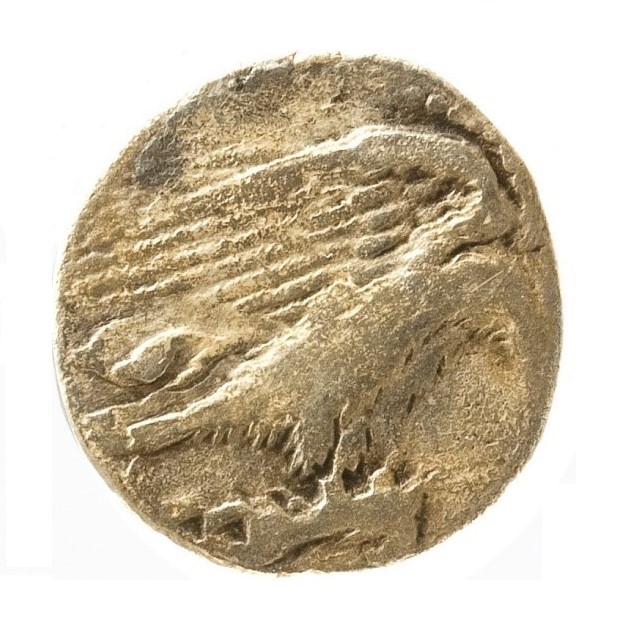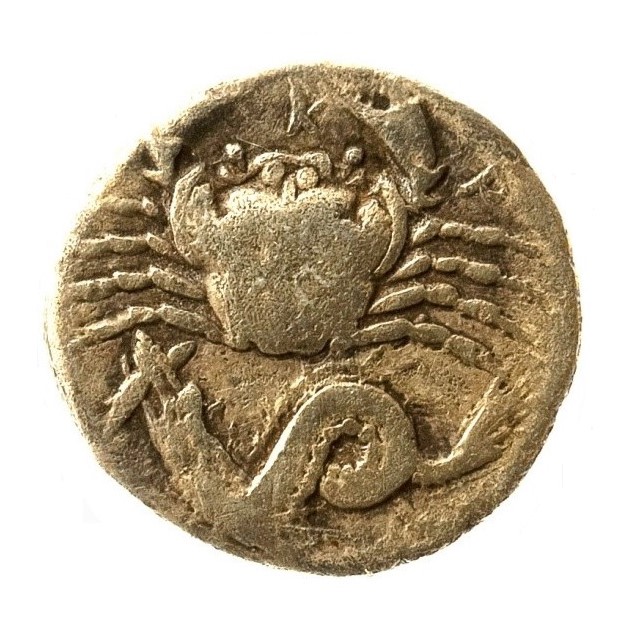Title: Hemidrachmon of Akragas (Agrigentum) - 1980.03
Acquisition number: 1980.03
Author or editor: Douglas Kelly
Culture or period: Classical Greece.
Date: c. 420 - 406 BC.
Material: Metal - Silver
Object type: Coins - Greek
Dimensions: 15mm (w)
Origin region or location: Italy
Origin city: Akragas (Agrigentum)
Display case or on loan: 5
Keywords: Coin, Greek, hemidrachmon, Sicily, Akragas (Agrigentum), Magna Graecia, Gela
Sylloge Nummorum Graecorum, USA, The Collection of the American Numismatic Society (New York, The American Numismatic Society, 1969-), 1010-3.
1980.03
Hemidrachmon of Akragas (Agrigentum)
Silver, 1.91 g. 15 mm. c. 420-406 BC.
Obv.: Eagle r. devouring a hare
Rev.: Crab andsea monster
A colony of the Sicilian city Gela (cf. 1990.01) that was settled c. 576 BC, Akragas (Roman Agrigentum, modern Agrigento) was the second-largest Greek city in Sicily after Syrakousai (Syracuse); it thrived on the export of agricultural produce to Carthage. The modern town occupies only a small portion of the area of c. 625 hectares enclosed by the walls of the ancient city. The great Doric temples at Akragas of the early fifth century BC (Temples A through to E) are amongst the largest and most impressive in the Greek world. It is not known, however, to which deities they were dedicated.
Akragas’ silver coinage began in the late sixth century, with the city’s badges--the eagle and the crab--as the obverse and reverse types respectively. In a change dated to c. 420 BC, the eagle on the obverse became an eagle (or on the tetradrachmon, two eagles) devouring a hare, and the crab on the reverse was accompanied by a fish or, as here, by some kind of sea monster. The significance of these new types is not known, but it is clear that they required a more refined kind of die-engraving.
Akragas was destroyed during the great Carthaginian invasion of 406 BC. Its coinage did not revive until the time of Timoleon (cf. 1981.04, Syrakousai [Syracuse]). In 210 BC, during the Second Punic War, Akragas was destroyed by a Roman army.
This coin is a hemi (half) drachma, being approximately equal to half of five Sicilian litrae of silver (cf. 1990.01) of 0.76 each (5 x 0.76 =3.80g.), which make up a drachma on the Sicilian weight standard.
Sylloge Nummorum Graecorum, USA, The Collection of the American Numismatic Society (New York, The American Numismatic Society, 1969-), 1010-3.

